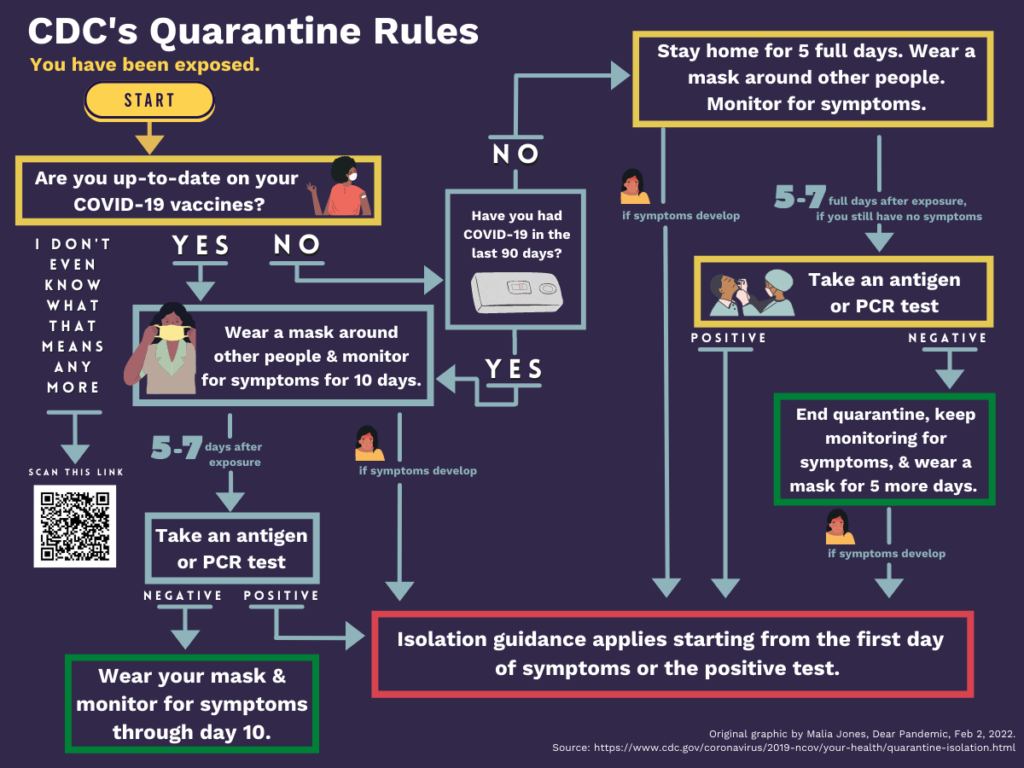QUARANTINE is not the same as isolation. Quarantine is what we do after we find out that someone we shared air with ended up being positive for COVID-19.
You’re feeling fine and haven’t tested positive, but you’re in a waiting period–waiting to see if you’ll get sick.
CDC’s guidance for quarantining after you have been exposed to COVID-19 is even MORE complex than the guidance for isolation, so if you are trying to puzzle this out, you’re not alone!
The rules depend on whether you are up-to-date on your COVID-19 vaccines. (Not sure what that means? Read here.)
💪🩹 If you are up-to-date on COVID-19 vaccines, then you don’t have to quarantine … but you do have to take some other special precautions. This not-quarantining doesn’t have its own word, which is inconvenient, so we’ll call it️ monitoring.🕵🏼♀️
Here’s what monitoring involves: for 10 full days, you need to wear a mask at all times when you are in public spaces. You should also avoid travel and contact with high-risk people. And, you should watch for symptoms. CDC also advises that you be tested between 5 and 7 full days after the exposure. Count the day of exposure as day 0.
🕵🏼♀️ Monitoring guidance also applies if you recently had COVID-19 (within the last 90 days).
🚫 If you are not up-to-date on your COVID-19 vaccines or have never been vaccinated at all and you are exposed to someone with COVID-19, you have to quarantine.
Quarantining means you should stay home for 5 full days, counting the day you were exposed as day 0. Wear a well-fitted N95 type mask around other people at all times, avoid travel, avoid high-risk people, and monitor for symptoms. If you have no symptoms after 5 full days, you may end quarantine. That is, you can go back to work/school/daycare/society. But you should continue to wear a mask strictly whenever you are around other people for 5 more days.

________
In either case, if you develop COVID-19 symptoms at any point, you should get tested and assume you have COVID-19. Isolation guidance will then apply, starting from the first date of your symptoms or the date of your positive test.
Don’t forget that symptoms include lots of things. Sore throat, fever, and cough are among the most common symptoms of the Omicron variant, but you can also have fatigue, diarrhea, rash, headache, loss of appetite, shortness of breath, runny nose, and loss of taste or smell. Any of these symptoms, at any level of intensity, is highly suspect after an exposure.
_______
Situations:
If you are in quarantine/monitoring and you develop symptoms or have a positive test, you have to begin a new countdown for your isolation period. Whatever days you spent in quarantine/monitoring do not count toward isolation days.
If you are quarantining/monitoring and you develop symptoms but your test is negative, you should test again or just assume you really do have COVID-19. Between the known exposure and the symptoms, the likelihood of a false-negative test is high here, especially on an antigen test. Of course, it could be something else, but it’s not likely.
If some members of your household were exposed and some other members of the household were not exposed: only the people who were actually exposed have to quarantine/monitor. That is until one of the exposed people falls ill; then the remaining housemates move into the exposed category themselves and must start their own quarantine/monitoring clocks.
If your child is not yet eligible for COVID-19 vaccines because they are too young: in this situation, your child should follow the quarantine guidance. They are not eligible for the reduced requirements of monitoring.
If you are exposed and you are quarantining/monitoring and then you are exposed again, you have to restart your quarantine/monitor clock for the second exposure.
In multiple-person households where several people are exposed, each person has their own quarantine/monitoring period and it starts at the time of their exposure.
If so many people in your district have Omicron that your school has said they can’t do contact tracing anymore, so just assume your child is exposed every single day: take a deep breath. Do what you can. Upgrade your masks if you can. Get your kids vaccinated if they are eligible. Use antigen tests strategically. Stay away from high-risk people and avoid travel if possible. Omicron will pass soon, we hope.
If someone you live with tests positive for COVID-19 or develops symptoms, you can consider yourself exposed and start that quarantine/monitoring clock. You do not need to await “official” notification. In fact, in many areas contact tracing is nonexistent so you may not ever receive an official notification.
____
Strict mask-wearing means wearing a mask that fits well and has good filtration, such as an N95 mask. Strict mask-wearing means the mask is covering your mouth and nose at all times, with no breaks for eating, drinking, applying Chapstick, scratching your nose, or doing anything else. Any mask breaks should happen away from all other people.
____
We did another post on the advice for isolation, which you can find here.
Source:


